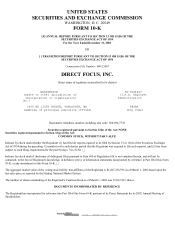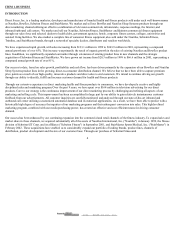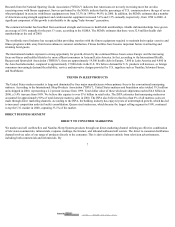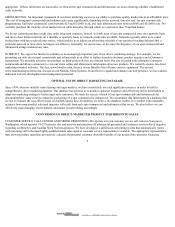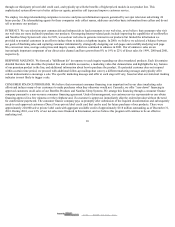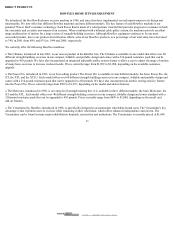Nautilus 2001 Annual Report Download - page 7
Download and view the complete annual report
Please find page 7 of the 2001 Nautilus annual report below. You can navigate through the pages in the report by either clicking on the pages listed below, or by using the keyword search tool below to find specific information within the annual report.
Research from the National Sporting Goods Association ("NSGA") indicates that Americans are not only exercising more but are also
exercising more with fitness equipment. Surveys performed by the NSGA indicate that the percentage of U.S. consumers above the age of seven
who participated in exercise with fitness equipment rose from 35.3% in 1990 to 44.8% in 2000. In addition, the SGMA estimates that a number
of Americans using strength equipment and cardiovascular equipment increased 5.4% and 3.5% annually, respectively, from 1990 to 2000. A
significant component of this growth is attributable to the aging "baby-boomer" generation.
The commercial market has benefited from continued strength and increase in health club memberships. Health club memberships have grown
an average of 5.0% annually for the past 13 years, according to the SGMA. The SGMA estimates that there were 32.8 million health club
memberships at the end of 2000.
The worldwide travel industry has recognized that providing travelers with the fitness equipment required to maintain their regular exercise and
fitness programs while away from home enhances customer satisfaction. Fitness facilities have become important factors in attracting and
retaining hotel guests.
The international markets represent a strong opportunity for growth, driven by the continued fitness boom across Europe and the increasing
focus on fitness and healthy lifestyles by more affluent consumers in Asia and Latin America. In fact, according to the International Health,
Racquet and Sportsclub Association ("IHRSA"), there are approximately 19,500 health clubs in Europe, 7,800 in Latin America and 4,800 in
the Asia/Australia market, compared to approximately 17,800 clubs in the U.S. We believe demand for U.S. products will increase, as foreign
consumers increasingly demand the reliability, service and innovative designs provided by U.S. suppliers such as Nautilus, Schwinn Fitness,
and StairMaster.
TRENDS IN SLEEP PRODUCTS
The United States mattress market is large and dominated by four major manufacturers whose primary focus is the conventional innerspring
mattress. According to the International Sleep Products Association ("ISPA"), United States mattress and foundation sales totaled 39.5 million
units shipped in 2000, representing a 2.2 percent increase from 1999. Total dollar value of these wholesale shipments reached $4.6 billion in
2000, a 5.4% increase from 1999. We believe this equates to over $7.6 billion in retail sales. The ISPA estimates that innerspring mattresses
accounted for approximately 90% of total domestic mattress sales in 2000. The ISPA also believes that less than 6% of all mattress sales are
made through direct marketing channels. According to the ISPA, the bedding industry has enjoyed years of uninterrupted growth, which has led
to increased competition and retail outlet consolidation. Queen-sized mattresses, which became the largest selling segment in 1998, continued
to top the U.S. market in 2000, capturing 33.1% of the market.
DIRECT BUSINESS SEGMENT
DIRECT TO CONSUMER MARKETING
We market and sell our Bowflex and Nautilus Sleep Systems products through our direct-marketing channel utilizing an effective combination
of television commercials, infomercials, response mailings, the Internet, and inbound/outbound call centers. The direct to consumer distribution
channel involves sales of our range of products directly to the consumer. This is derived almost entirely from television advertisements,
including both commercials and infomercials. By
7
2002. EDGAR Online, Inc.

